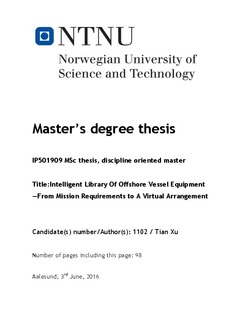| dc.contributor.advisor | Gaspar, Henrique M. | |
| dc.contributor.author | Xu, Tian | |
| dc.date.accessioned | 2016-10-26T07:16:54Z | |
| dc.date.available | 2016-10-26T07:16:54Z | |
| dc.date.issued | 2016 | |
| dc.identifier.uri | http://hdl.handle.net/11250/2417641 | |
| dc.description.abstract | The topic of this thesis is Intelligent library of offshore vessel equipment, from mission requirements to a virtual arrangement. The objective of this study is to generate the corresponding alternative equipment arrangement design solutions by developing a data-based library, and further make comparison among those solutions to select a relatively better equipment arrangement design solution through essential evaluation method. Alternative arrangement design solutions will be made in 2D by a web-based APP while a virtual 3D arrangement prototype will be simulated in Siemens-NX. | nb_NO |
| dc.description.abstract | This report is mainly divided into three categories: background, methodology development, case attempt. The background gives a brief introduction regarding to the expectation of the intelligent library along with some advanced concepts such as product architecture, product platform and modulization, which will be beneficial for constructing the intelligent library. | nb_NO |
| dc.description.abstract | The methodology of the intelligent library is developed in the second part. The conceptual design of the intelligent library is defined in the early stage, along with the confirmation of the scope of the data-based library. The core idea of the intelligent library is developed by utilizing some advanced concepts including product architecture, product platform and modelization. Further, the specific process algorithm is created and implemented by applying some special methods inside (like equipment compatibility matrix) in order to make some balances in each potential equipment arrangements. | nb_NO |
| dc.description.abstract | For evaluating the feasibility of the intelligent library, a case study is performed by following the 6-step process algorithm. Essential assumptions have been made in advance in order to operate the whole procedure much more swimmingly. Eventually, four potential design solutions are proposed while one of them is evaluated and stand out as a relatively better equipment arrangement design solution. Furthermore, the corresponding 3D prototype of the better arrangement is made in order to give both ship designers and ship owners a more comprehensive visual feeling about the layout of the arrangement. | nb_NO |
| dc.description.abstract | Last but not least, some deficiencies in relation to the methodology and simulation are identified and summarized, along with the further prospects regarding to the improvement of the intelligent library. | nb_NO |
| dc.language.iso | eng | nb_NO |
| dc.rights | Navngivelse-Ikkekommersiell-IngenBearbeidelse 3.0 Norge | * |
| dc.rights.uri | http://creativecommons.org/licenses/by-nc-nd/3.0/no/ | * |
| dc.subject | Vessel equipment | nb_NO |
| dc.subject | Data-based library | nb_NO |
| dc.title | Intelligent Library of Offshore Vessel Equipment - From Mission Requirements to A Virtual Arrangement. | nb_NO |
| dc.type | Master thesis | nb_NO |
| dc.subject.nsi | VDP::Technology: 500::Marine technology: 580 | nb_NO |
| dc.source.pagenumber | 98 | nb_NO |

